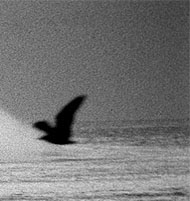|
Eisbach:
Germany´s most famous wave is a river wave. It is situated in München (Munich) in the far south of the country. The closest ocean to that place is the mediterranean sea and is a 7 hours drive away. But despite that very inland situation, München is, together with Sylt at the north sea, the nucleus of german surfing. With windsurfing becoming very popular in this area in the early seventies, plenty of people good hooked with boardsports performed in the water.
Pretty soon some of these windsurf afficionados got frustrated with the usually windless state of the many lakes south of town. We don´t know if the famous bavarian beer from the infamous beer garden “Chinesischer Turm” (chinese tower) in the “englischer Garten” (english garden), a large park right in the center of München, is to blame for it, but one day somebody realized the potentials of the Eisbach, a small river crossing the Englischer Garten. This little river is running very fast and some day somebody took a board of wood, fixed a rope at a tree and started some sort of waterskiing in the river. Even though the board itself didn´t move much, the fast running river made the board planning and created the impression of moving pretty fast on the river. “Brett´l fahrn” (let´s call it “bungee boarding”) was born.
A little later things got more sophisticated and people started to use flexible ropes that gave the opportunity to add more juice to the thing. By pressing the “rails” of the board into the current one could stretch the rope to the max, than trim the board flat and this way gain plenty of speed. People even started doing jumps.
Meanwhile - in the early eighties - the windsurfing folks had swarmed Europe´s oceans and had started wavesailing. There they found out about a “brand new” sport called surfing. Back home some of them looked for ways to fight the surf turkey and started to do the “Brett´l fahrn” thing with surfboards. And one day somebody dared to surf the standing wave of the Eisbach. At the beginning it was a mixture of vehicles that got used at this wave. Booogie boards were used, kiteboard like boards with straps were ridden with the help of a rope tied to the bridge in front of the standing wave and the first real surfboards were damaged at the walls on both sides of the narrow river and the underwater obstacles.
More or less from the beginning, it was an ilegal thing to bungee board or later surf the river. At times surfers were running away from the police chasing them and often a jump into the fast running river was the only way to escape from the green men.
But that didn´t hinder a fast growing group of surfers to get sort of an ocean feeling at the Eisbach and the other surfable standing wave in Munich, the “Floßlände”
Pretty soon, they had it pretty wired and as the wave never stops breaking, rides longer than everything you can do at most ocean waves got common. In the early ninethies, especially on sunny summer days, the combination of the number of surfers and the lenght of the rides started to create problems with overcrowding. Even first glimpses of localizing showed.
The wave was featured in surf magazines around the wourld and got pretty well known in the surfing wourld.
>>> next page pics this side by Flo Hagena
|

